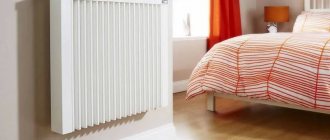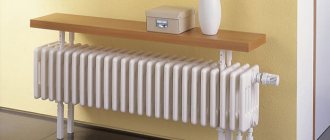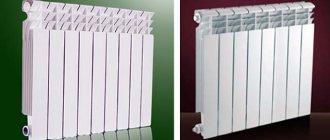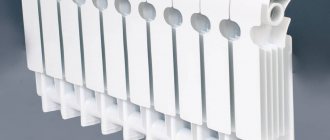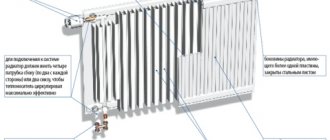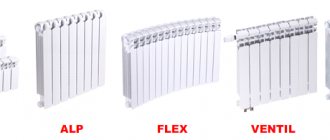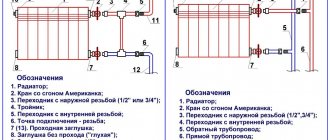Where are aluminum radiators used?
The main condition for life support in any apartment or private house is the presence of a heating system. The coolant, which is heated by autonomous heating equipment or in the boiler circuits of the central boiler room, circulates through pipes and radiators. And through convection or thermal radiation, heat spreads throughout the room.
Aluminum radiators have the best price-quality ratio. They are installed both in centralized heating systems and in individual ones. But we must keep in mind that aluminum radiators react to the presence of acids and alkalis in the coolant.
According to their design, they are sectional or panel. Most often you can see sectional products on sale that are connected using nipples. To seal the joints, special gaskets are used. According to the technical characteristics stated by the manufacturers, different models of aluminum radiators can withstand pressure from 6 to 18 atmospheres. Some models have stated limits of 25 atmospheres. This is important when installing products in central heating systems. When choosing and comparing how heating batteries differ from each other, these parameters must be clarified in advance.
How to distinguish devices visually
External factors often mislead buyers. The batteries have a similar appearance - metal rectangles with flat ribs and the same number of sections. To distinguish devices with an identical number of elements, you can pick them up right in the store. Aluminum ones will be lighter.
The second way to check is with a magnet, regular or neodymium. The product must be moved from the edge to the center. The steel surface will create a slight attraction.
When choosing radiators made of aluminum and bimetal, you need to compare several factors - cost, installation features, heated area. Owners of private houses can opt for aluminum options; in apartments, bimetallic ones are justified.
Positive properties of aluminum batteries
Aluminum radiators are light and durable, easy to transport and install. In addition, they also have a number of important advantages:
- small sizes (shorter in width compared to cast iron);
- very high level of heat transfer;
- operating pressure corresponding to the needs of modern heating systems;
- you can select a product with a certain number of sections according to the heated area;
- good heat transfer, which means efficiency;
- the ability to adjust the temperature using built-in thermostats;
- excellent aesthetic appearance.
The advantages of aluminum radiators over bimetallic ones are their lower price, which is very important for the consumer.
Features of radiator installation
If the system is mounted horizontally, it will be difficult to bleed air
When installing batteries yourself in a private house or cottage, the following rules and regulations should be observed:
- radiator length – 55-75% of the width of the window opening;
- distance to the wall – 30-50 mm, to the floor – from 100 mm, from the window sill – from 50 mm;
- batteries should be mounted under the window, not far from the door - in places with the greatest air circulation;
- The central axis of the radiator coincides with the central axis of the window, the recommended deviation is 20 mm.
When installing the radiator, you will need sealant
When installing bimetallic or aluminum radiators, the packaging is not removed until the work is completed to avoid accidental damage. With natural circulation of liquid in batteries, it is permissible to install up to 12 sections, with artificial circulation - up to 24. In addition to radiators, you will need:
- sealant;
- sealing tape;
- torque wrench;
- thermostats and shut-off valves;
- fasteners (brackets);
- squeegees of different sizes.
Mayevsky crane for air release
Temperature regulators, shut-off valves and a Mayevsky valve are installed on the batteries, through which air is vented. Level brackets are attached to the walls, and radiators are hung on them. They should hold tight and not wobble. Then the plugs are unscrewed; for a one-pipe system, a bypass with a valve is installed; for a two-pipe system, a discharge with a valve is installed. Use a torque wrench to connect the pipes to the fittings so as not to overdo it when tightening the nuts (the torque limit is indicated in the instructions for the fasteners). A weak connection can lead to leaks. The joints are sealed with sealant or sealant.
Connection methods
According to SNiP, radiators can be connected from the side, bottom or diagonally. The most common is a lateral connection, in which the inlet and outlet pipes are located on one side of the battery. With a bottom connection, the input is connected to the lower fitting on one side, and the output is connected to the lower fitting on the other side. In this case, heat transfer is reduced by 10-15%. The most advantageous is a diagonal connection, when the input is connected to the upper fitting on one side, the output - to the lower fitting on the other side.
Can be connected in series or parallel. The first method involves a closed system in which the inlet pipe of one battery is the outlet pipe for another. If there are no bypasses, in order to repair one battery, you need to turn off the entire system. Bypass is a tube connecting the input and output of each battery. In parallel, connect each radiator to the main pipe.
Cons of aluminum radiators
Any product has some pros and cons. Consumers have to weigh the pros and cons when they compare the differences between heating radiators.
The disadvantages of aluminum radiators are the following:
- high demands on the coolant: it should not contain acids or alkalis;
- all aluminum radiators must have air venting devices in order to promptly remove air pockets;
- aluminum radiators are connected to the heating system only using aluminum pipes;
- weak points - connections of sections that can leak under load;
- heat is distributed unevenly, the hottest places are the fins of the radiators;
- The service life of an aluminum product is about 15 years.
If you handle the aluminum product carelessly during installation, it can be damaged, since the material is quite fragile. Therefore, this work should be done by a professional. The listed disadvantages help to understand the difference between an aluminum radiator and a bimetallic radiator.
Pros and cons of radiators made of different materials
Metal batteries can be connected to the heating system of a private house or apartment. Before connecting, you need to understand the pros and cons of the devices.
Aluminum radiators
Due to the lightness of the material, they are easy to transport, as well as a number of advantages:
- compactness - the width of sectional elements is less than that of cast iron;
- high heat transfer;
- ability to withstand high pressure;
- ease of temperature control using a thermostat;
- selection for the design of any room.
The disadvantages of aluminum batteries include:
- compatibility only with neutral acid-base composition of water;
- the need to install air vents to prevent traffic jams;
- risks of leaks at connections;
- uneven heat transfer.
The main part of the thermal energy is concentrated on the fins of the aluminum sections.
Bimetallic radiators
The complexity of the production technology (injection molding, spot welding) affects the cost of the device. Bimetallic products have a number of advantages:
- economical coolant consumption due to the small internal volume;
- compatibility with any coolant composition;
- ability to withstand pressure with performance indicators up to 40 atm;
- minimum liquid temperature in pipes is 130 degrees;
- high heat transfer achieved with aluminum fins;
- coating durability - painted in two stages with surface polymerization.
The disadvantages of bimetal include:
- low heat transfer due to the steel core;
- operating costs - due to high hydraulic resistance, more energy is needed to pump coolant;
- risks of steel corrosion due to improper use.
Paronite seals are used to connect bimetallic sections.
Features of a bimetallic radiator
Bimetallic radiators are a new technology for manufacturing heating products. To know how to distinguish bimetallic radiators from aluminum ones, you need to understand their internal structure, which combines materials with different performance characteristics: aluminum and stainless steel. The bimetallic radiator successfully takes into account the positive aspects of these two metals.
What are bimetallic radiators? Structurally, these are steel pipes with aluminum sections. Such products are considered most suitable for installation in central and individual heating systems.
The sections are made of aluminum, so they have maximum efficiency and instantly transfer heat to the room. When asked how aluminum batteries differ from bimetallic ones, they always compare the price - for bimetallic ones it is much higher.
The technology for its production is complex. High-quality products are cast under high pressure. To reduce cost, manufacturers sometimes use welding, which does not greatly affect the strength of the radiator.
For reference. The manufacturing technology of bimetallic radiators allows them to be installed in systems with any operating pressure, since the internal part of the product is made of high-quality steel.
The main difference between bimetallic radiators and steel ones is that they are reliably protected from corrosion by an aluminum casing.
Radiator selection: steel, aluminum or bimetallic
One of the main components of the heating system of an apartment or house are radiators. Today, in many apartments of our compatriots there are old-style cast iron batteries. And, of course, almost everyone is faced with the problem that on the coldest days the rooms are cool and uncomfortable. Many people turn to utility companies with such complaints, but the lack of heat in the room can also be associated with batteries that have long served their purpose and should be replaced. Another reason for replacing radiators is often their mediocre, outdated design.
The question arises quite logically: what should we change it for? To choose the ideal option for your home, you will have to take into account many nuances by studying the characteristics of various options offered by Russian and foreign manufacturers.
Today's market for heating devices, in addition to cast iron batteries, includes radiators made of steel, aluminum and bimetal. The popularity of these materials has recently increased, since such batteries are functional, have excellent thermal conductivity and low inertia.
So which radiators are better - steel, bimetallic or aluminum? A review of the main pros and cons of aluminum, bimetallic and steel batteries will help you understand this issue.
Aluminum radiators
Radiators made of aluminum are in great demand. Due to the properties of metal, such batteries have excellent heat dissipation, and the low weight of the metal ensures ease of transportation and installation.
The designs of various aluminum radiators have virtually no differences. All of them are fairly light sections, with pipes running between them with constantly circulating heated coolant. The power of such radiators depends on the number of sections and can be easily adjusted. The quality of batteries of this type will determine fuel consumption, which can be reduced by up to 30%.
The advantages of aluminum radiators include:
- light weight;
- modern design;
- high heat transfer rates.
The main disadvantages of these radiators, first of all, include high sensitivity to the quality of the coolant. In other words, if the content of alkalis and acids in process water is critical, then the aluminum radiator will quickly fail. Aluminum is a reactive metal and therefore has a high corrosion risk. The greatest risk of failure is for batteries installed in systems with steel pipelines immediately before the start of the heating season.
Steel radiators
The design of steel radiators has several significant differences from aluminum ones. First of all, steel heating devices are equipped with special side plates that are connected by welding. Also, manufacturers produce two types of steel batteries - with bottom or side connections. You need to choose the type of connection in each case individually, because its type depends on the location of the main pipeline.
The advantages of steel radiators are:
- functional design, equipped with removable panels;
- long service life;
- low inertia;
- good strength of products;
- speed and ease of installation;
- large selection of configurations and sizes;
- fairly rapid heating and cooling of the heating device;
- the best ratio of quality and price.
Despite the fact that no problems arise during the operation of steel radiators, they still have some disadvantages. One of the main disadvantages is the thin walls of the pipes of these batteries. Basically, manufacturers of steel heating devices recommend using them with a maximum pressure in the system not exceeding 15 atmospheres. Pressure values in central heating can reach 20 atmospheres or more. Therefore, it is better to use them in individual heating systems.
Which is better: aluminum, steel or bimetal?
Having carefully studied all the pros and cons of steel, bimetallic and aluminum radiators, it is not difficult to understand which one is better. All heating devices have positive characteristics of quality and heat transfer, but at the same time, bimetallic batteries are more resistant to wear and less sensitive to corrosion.
To choose the right radiator, first of all, you need to take into account the characteristics of a specific hydraulic network. Aluminum radiators are best installed in cases where the quality of the coolant is beyond doubt. Therefore, in city apartments it is better to install steel or bimetallic radiators, the service life of which will be much longer than aluminum ones.
If you require additional advice on the plumbing services provided, write or call us:
+7
+7
Source: https://santehbrigada.ru/vybor-radiatora
Advantages of bimetallic batteries
An important advantage that allows you to save energy resources is the small internal volume of the bimetallic radiator. This means that these devices require a small amount of coolant. This does not affect the intensity of air heating in the heated room. The aesthetic appearance of the products will fit perfectly into any interior.
List of advantages of bimetallic radiators:
- The product can withstand any pressure in the system;
- when comparing how bimetallic heating radiators differ from aluminum ones, it should be noted that they can be installed in heating systems with any acid-base balance of the coolant;
- the connections of the sections are very reliable (paronite seals are used);
- large margin of safety of the product;
- the appearance does not deteriorate over time due to durable coloring;
- bimetallic radiators serve for more than a quarter of a century due to the use of steel pipes in the design;
- have maximum heat transfer due to aluminum fins.
For reference. Installing such radiators is not difficult. If necessary, you can build up additional sections without removing the already installed radiator. This is very convenient when the heating system has already been installed, but the decision has been made to enlarge the radiator.
Advantages and disadvantages
Each of the heaters has its own pros and cons. Steel or aluminum radiators for an apartment or office are chosen after a thorough assessment of the parameters.
Steel
Steel radiators are more susceptible to water hammer
The steel panel heater was developed during the energy crisis. It is served by a small volume of water and meets all energy saving requirements. Tubular ones are less economical and not as effective.
Advantages:
- high efficiency - a large working surface ensures quick heating of the room;
- easy temperature adjustment due to the small volume of coolant; the heating system can be equipped with automatic regulators;
- operating pressure in the system – 9–10 atm;
- laconic and strict design;
- Easy to care for – the smooth surface is easy to wash and paint.
The disadvantages of the model include:
- low resistance to water hammer;
- draining the coolant provokes metal corrosion;
- The devices are not compatible with some polypropylene pipes.
Bimetal
If air gets inside a bimetallic radiator, the steel core quickly rusts
This option combines the positive qualities of steel and aluminum. Its heat transfer is 20% lower than that of aluminum, but almost 2 times higher than that of iron. However, you need to decide which radiators are better - steel or bimetallic - after assessing other features.
Advantages of the 2-metal model:
- high heat transfer;
- low sensitivity to impurities in water - corrosion does not threaten bimetallic radiators;
- weak thermal inertia;
- resistance to high pressure - the operating rate is 25 atm, the battery can withstand water hammer up to 60 atm;
- The devices are lightweight, which simplifies installation;
- durability - the factory warranty on the product is 20 years.
Flaws:
- the cost is 15–40% higher than other heating devices;
- if oxygen enters the system, the alloy quickly rusts;
- In low-quality products, leakage is possible at the junction of aluminum and steel.
Differences between bimetallic radiators and aluminum ones
When it is advised to buy cheaper models, many of the models’ shortcomings are not taken into account. Therefore, sometimes you have to “pay twice” and redo the entire heating system from scratch.
To prevent this from happening, you need to know how heating radiators differ and what are their similarities:
- Bimetallic aluminum radiators are very similar in shape: flat rectangular white casings.
- Radiator models can consist of several sections. You can select the appropriate number of sections to suit the size of the heated area.
- The fundamental difference between aluminum heating radiators and bimetallic ones is that during operation, aluminum ones can be destroyed if the coolant pressure is higher than permissible according to technical characteristics (on average, 12 atmospheres). Bimetallic radiators can withstand voltage three times higher.
- Since steel is heavier than aluminum, bimetallic radiators weigh more. When there are many sections, the difference is significant: 1 section of a bimetallic battery is 0.5 kg heavier than an aluminum one.
- The service life of a bimetallic device is at least 25 years; for an aluminum device, 15 is the limit.
Popular types of radiators
Bulky cast iron batteries are slowly becoming a thing of the past, being replaced by elegant radiators. Such designs give off excellent heat and look attractive.
The cost of the products is relatively high, but taking into account the long-term service, the investment pays off in the long term. By updating the heating system, the consumer will find out which heating radiators are best for a private home
There are bimetallic and aluminum sections available in stores, and each type has its own advantages and disadvantages.
Pros and cons of aluminum heating radiators
Neat and attractive aluminum batteries include several sections connected by nipples and sealed with special gaskets. The inner side has a ribbed surface, increasing the heat transfer area to 0.5 m2. According to the manufacturing method, they are divided into solid cast and extruded. The first ones are more expensive and more durable, the second ones are light and budget-friendly.
Let's look at the main advantages and disadvantages of such radiators:
The disadvantage of such models is considered to be poor tolerance to pressure surges and fragility during water hammer. The working pressure of an aluminum radiator is 6-16 atmospheres, less often 20. Needless to say, the installation of aluminum radiators in multi-storey buildings is not recommended, because it is difficult to control the centralized heating supply. In private construction, such a problem does not arise, because a separate heating system (HS) is not subject to uncontrolled changes in operating pressure and water hammer. In terms of heat transfer, an aluminum product leaves other types of heating structures far behind. One sectional unit emits up to 200 W of thermal energy: part transmits convection heat, while the second transmits infrared radiation. There is also minimal thermal inertia, which is extremely useful in a private home. Almost immediately after starting the system, the room becomes more comfortable. The most common coolant is plain water. The product is available, but at the same time, the salts and other components contained in the water react aggressively with the aluminum surface
Due to the chemical activity, it is extremely important to monitor the pH status. An indicator that exceeds 8 units is detrimental to the radiator - it will be “eaten up” by corrosion
Hydrogen is also released which can cause a fire or battery explosion. Air should be removed from the sections in a timely manner. The maximum coolant temperature should not exceed 110 degrees, which is also a disadvantage of aluminum radiators.
Bimetallic radiators - a combination of the best qualities of metals
First, let's figure out how bimetallic heating radiators differ from aluminum ones? The main difference is the bimetal’s resistance to pressure changes. This allows radiators to be used universally both in apartment buildings and in private homes. Bimetallic radiators are reliable in conditions of water hammer. This is ensured by an internal steel or copper core through which the coolant moves. This structure allows you to withstand operating pressure within 20-40 atmospheres. Here is a list of other benefits:
- Low requirements for coolant. Steel and copper are not as susceptible to chemical composition, therefore, oxidation and corrosion processes do not develop as quickly as in an aluminum battery.
- The highest temperature of the coolant is 130 degrees.
- Durability - service life is on average 1.5-2 times higher than that of aluminum.
Bimetallic radiators still have some disadvantages compared to single-component metal products. Heat transfer rates are lower: depending on the manufacturer, the difference can reach a 5-fold value in favor of aluminum. The price for one section made of bimetal is higher, which is also not considered an advantage.
Conclusions from comparative characteristics
When purchasing radiators, you need to take into account the main performance characteristics: the ability to withstand significant pressure drops, resistance to corrosion processes, the strength of section connections and, ultimately, the durability of the product.
Aluminum ones can be installed in private households, where it is possible to control the quality of the coolant and the pressure in the system. They will serve well for many years. Home owners will receive good quality at an affordable price. However, you should not install such radiators in houses where antifreeze is supposed to be used as a coolant.
Bimetallic ones are ideal for apartment buildings where space heating is done centrally. They can withstand high pressure and are suitable for coolant of any composition.
It is difficult to say how to distinguish bimetallic radiators from aluminum ones externally: both radiator options are well designed. Therefore, they can be placed in any room and not be afraid that they will not fit into the interior.
How a battery differs from a radiator is its ability not only to release, but also to accumulate heat. In this regard, of course, cast iron models win. However, they are excessively heavy, expensive and are justified in houses where the heating system runs on solid fuel. In other cases, it is more convenient to install modern heating devices made of aluminum or bimetallic, which are convenient to install even yourself. The radiators are supplied with wall brackets, air vents and other elements necessary for installation.
Which radiators are better: aluminum or bimetallic?
Aluminum radiators appeared 30 years ago and immediately won a significant market share from the usual steel and cast iron batteries. These products gained popularity due to their unique appearance, increased heat transfer and low weight. In terms of heat transfer, aluminum batteries are the undoubted leaders, but due to the behavior of the material from which the product is made, the use of these devices is not always possible.
Construction of aluminum radiators
Aluminum heaters are produced using two technologies:
- The finished product is cast in molds.
- The radiator is assembled using the extrusion method.
In the first option, a monolithic product is obtained that perfectly withstands network pressure due to the absence of connecting seams and connections.
In the second option, aluminum profile blanks are used, which are processed using a press. The individual sections obtained in this way are connected into a battery by welding. To ensure tightness, the sections are connected using seals and special gaskets.
A prefabricated radiator is cheaper than its monolithic counterpart, but, subject to the requirements of production technology, it has the same strength characteristics. The advantages of monolithic models include the ability to operate the product without additional maintenance, while prefabricated models are subject to periodic technical inspection and maintenance work.
Characteristics
Aluminum is a metal with a high degree of thermal conductivity. This feature allows you to create a powerful heat wave from the battery, which is evenly distributed throughout the space of the heated room in the apartment.
Thermal power is measured in W and is, for a single section of an aluminum battery, at least 180 W. This product weighs within 2 kg, thickness does not exceed 110 mm. To completely fill such a radiator you will need 0.4 liters of liquid. The maximum limit on the carrier temperature is +90oC.
Advantages and disadvantages
The advantages of aluminum batteries include the following:
- thanks to the rapid heating of the material, the process of heating the room occurs quickly (for living rooms, 15-20 minutes are enough to obtain a comfortable temperature), which allows for significant (up to 35%) savings on heating fluid costs;
- To regulate the flow of coolant, each product has a special thermal valve, which allows you to reduce or increase the flow of liquid in the radiator, which also leads to
- saving heating resources;
- aluminum radiators look very attractive in appearance, even elegant - small, but powerful in terms of heat transfer, the products fit perfectly into the interior of a private house, cottage, or
- administrative premises;
- if necessary, the owner of a private house can independently add sections to already installed prefabricated heating radiators (it is better for professionals to work with cast models);
- Due to their small size and weight, these products are easy to install in any room and on any surface.
Aluminum radiators also have negative qualities. These include the following points:
- aluminum not only heats up quickly, but also cools down quickly, which is why in order to maintain a comfortable atmosphere in the room it is necessary to constantly maintain the required level of coolant supply;
- radiators made from this metal cannot withstand high pressure in the heating network, so they are not suitable for use in apartment buildings - they are more often installed in wooden country cottages or in small autonomous buildings;
- prefabricated structures are equipped with rubber gaskets; over time, these elements wear out and require replacement, which creates certain inconvenience for the owners; also, this feature does not allow the use of the types of batteries in question when using special liquids with an aggressive chemical composition, such as antifreeze, as a coolant;
- if the coolant has a high content of alkaline compounds, destruction of the material and failure of the radiator occurs, therefore it is advisable to use aluminum products in small private buildings where problems with excessive concentration of foreign substances in the water do not exist;
- When water and aluminum combine, a weak process of gas formation occurs, therefore, to bleed air and remove plugs, Mayevsky taps must be installed on the products.
Mayevsky crane.
Bimetallic radiators
Bimetal radiators are visually no different from aluminum products. They are also compact and aesthetic, but due to the use of steel in the structure, the weight of bimetal heaters is slightly greater.
Which radiators are better - aluminum or bimetallic - can be understood if you understand the structure of each system and compare them.
Thus, thanks to the reinforcement of the product structure with a steel base, bimetallic radiators can withstand higher coolant pressure without damage, which significantly expands the scope of their application.
Device
To obtain a high-quality radiator using two metals, steel and aluminum, a complex casting process using high pressure is required. Thanks to the distribution of metal under pressure in the mold, a tight bond of two different materials is achieved, which is necessary for high-quality heat transfer.
The steel core absorbs the pressure of the coolant and, through contact with the aluminum shell, transfers energy into the room.
Comparison of aluminum and bimetallic radiators
Externally, both types of heaters are absolutely identical, and an untrained consumer will not be able to distinguish an aluminum product from a similar one made of two metals. These types of batteries differ only in parameters:
- The heat transfer of aluminum radiators is higher than that of bimetallic ones;
- the ability to resist network pressure is almost twice as high for bimetallic products;
- the ability to resist corrosion is higher for bimetallic radiators in which the core is cast from stainless steel;
- the service life of aluminum products is about 10 years, and bimetallic radiators are designed for 25 years;
- the cost of bimetallic devices is 30% higher.
How to distinguish an aluminum radiator from a bimetallic one
Knowing the differences between the batteries in question, you can easily determine which product is offered in the store. It is necessary to pay attention to the following points:
- the connecting thread in the bimetallic radiator is made of steel;
- the weight of a bimetallic battery, with the same dimensions, will be significantly higher than an aluminum radiator;
- the easiest way is to check the material with a magnet: a magnet will not be attracted to a product cast entirely from non-ferrous metal - this method of checking is convenient for determining
- material of the already installed battery.
Copper radiator
This type of battery is not the most popular, largely due to inflated prices. But due to their technical characteristics, these models can seriously compete with bimetallic models.
What is their advantage? In fact, these products are made from high quality copper. No impurities are added to it, which increases the strength of the device.
Sectional model of a bimetallic radiator
Also, copper radiators have many advantages that distinguish them from other models. For example, high efficiency. Compared to cast iron radiators, the power of copper batteries is 5 times higher. They heat up a room in literally minutes, while using minimal energy.
Copper is a material that can prevent the formation of various pathogens that can harm human health.
These units can be installed in apartments where there is a central heating system, as well as in multi-storey buildings where there is individual heating. It is also worth noting that such models are not afraid of serious water hammer.
They can be used with high-temperature media, which can heat up to one and a half thousand degrees Celsius.
Copper gets along well with antifreeze. If the radiator is covered with copper, then it does not need treatment in the form of painting, which has a positive effect on heat transfer.
Copper is resistant to corrosion. A long service life can also be noted. Copper batteries always look attractive. You can also note the variety of different styles, types, shapes and sizes, which allows you to fit a copper radiator into a modern interior.
Consequences of water hammer
Finally, another plus is high efficiency. This criterion is very important when choosing a radiator.
There are also disadvantages that are inherent in a copper radiator. Among these disadvantages are the high cost, as well as the requirements for the pipe material. These requirements also apply to the quality of the coolant.
Battery installation
Copper batteries can only be connected to copper piping. Otherwise, a chemical process will begin to manifest itself, which can lead to corrosion and destruction of products.
What choice should you make when choosing a radiator for your apartment? You can take into account not only the technical characteristics, but also the operating conditions of the central heating system. This determines the choice of parts.
There are many more criteria that are worth looking at when choosing radiators. For example, working pressure
You can find out its value in the product passport, but you need to pay attention not only to this factor. Remember that this figure can be exceeded by almost one and a half times
It is necessary to take into account not only this point, but also the operational features of your utilities. After all, it is differences in operating pressure that can cause failure of modern radiators.
In five-story houses, which are made in the old layout, the pressure can reach up to 8 atmospheres. At the same time, modern high-rise buildings can boast a pressure of 15 atmospheres
Therefore, it is important that your radiator can withstand water hammer. In order to protect products from water hammer in apartments, it is important to objectively evaluate the work of public utilities, and also give preference when choosing those models that can boast a high degree of resistance to water hammer
Let's make a closer comparison of aluminum and bimetallic batteries
Now, having understood the characteristic features of both types of heating devices, to summarize, we can compare them according to their main characteristics.
Let's compare the parameters of aluminum and bimetallic batteries...
- Heat dissipation . If we compare this parameter of two radiator options, it is quite obvious that the heat transfer is almost the same and amounts to about 200 W from each section. Aluminum radiators heat up faster and heat the room, but also cool down faster, while bimetallic radiators take longer to gain heat, but also retain heat better.
- Resistant to high pressure . In this parameter, aluminum radiators “let us down”, since they are able to withstand a working pressure of no more than 16 bar, and this may not be enough during water hammer. The aluminum walls of the sections are quite thin and can burst under high pressure loads. Bimetallic batteries can withstand a pressure of 40 bar, and in this capacity they are significantly superior to aluminum ones. This parameter is especially important to consider if you are choosing devices for installation in a central heating system. But for autonomous systems, you can generally ignore this criterion - such pressure indicators simply do not exist in them.
- “Pickiness” to the quality of the coolant . Aluminum easily reacts with various chemical compounds, the concentration of which in the coolant from the central heating system can be considerable. Plus, it is susceptible to oxygen oxidation. Therefore, aluminum radiators under unfavorable conditions will quickly be “eaten up” by corrosion, and water hammer will complete its “dirty deed”.
You may be interested in information about what to consider when choosing electric heating boilers
Bimetallic batteries have internal channels made of a stainless steel alloy, which is resistant to chemical impurities of the coolant. In addition, many manufacturers additionally coat the inner walls of collectors and vertical pipes with a special anti-corrosion layer. This means that the chemical composition of the coolant will not have a special effect on the integrity of the radiators - they can be installed in the central system.
- Resistance to high temperatures. Aluminum radiators can withstand a coolant temperature of 110 degrees, and bimetallic radiators up to 130, and in this the latter have a significant advantage.
- Duration of trouble-free operation. Manufacturers usually set a service life of a maximum of 10 years for aluminum heating devices. In contrast, bimetallic radiators will last at least 15–20 years, so their advantage is obvious.
- Easy to install. It should be noted here that both battery options are mounted almost identically, since they are relatively light in weight and do not require particularly powerful brackets. But in any case, it is best to entrust the assembly and integration of radiators into the system to experienced professional craftsmen.
- Price. If we compare the current level, the prices for bimetallic radiators are approximately 20–30% higher than the cost of aluminum ones.
Based on the comparisons presented above, we can conclude that despite the difference in cost, for apartments it is more profitable to purchase bimetallic radiators from these two options. But for autonomous systems of private houses, aluminum batteries should be the best option.
You may be interested in information about what properties bimetal has
Prices for popular bimetallic radiators
What types of radiators are there and how do they differ?
By design, all hydraulic heating devices can be divided into four main types: sectional, panel, tubular (this includes heated towel rails) and convectors.
Sectional heating devices
Such devices consist of separate heating elements-sections. Sectional heating devices can be made of aluminum, cast iron, steel, as well as so-called bimetallic ones (having an aluminum body and a steel pipe through which the coolant moves). The sections are connected to each other using nipples, and seals are installed between the sections. More often, gaskets are made of rubber, which is normal when using water as a coolant, but is unacceptable when using antifreeze as a coolant, because rubber can be destroyed by its aggressive influence (in such cases, special seals are used in modern heating devices).
Panel (non-sectional) heating devices
These are mainly steel panel radiators. The design of a panel radiator is, roughly speaking, two steel sheets welded together (usually 1.25 mm thick) with vertical channels in which the coolant circulates. To increase the heated surface, and, as a result, heat transfer, steel U-shaped ribs are welded to the back side of the panel.
Tubular heating devices
In most cases, the design of such radiators consists of vertically arranged curved steel tubes connecting the upper and lower collectors. It is worth noting that steel tubular radiators are usually the most expensive type of radiator (in terms of 1 kW).
Convectors (or plate heaters)
A convector, figuratively speaking, is one or several pipes (through which the coolant moves) with metal “ribs-plates” “put on” them. The air passes through the convector from bottom to top, heating up from numerous warm fins. Such heating pipes are usually made of steel or copper. In some convectors, the amount of heat flow is regulated by a special damper, by opening or closing which you can increase or decrease the flow of moving heated air. The design of the convector can be completely open or closed with a decorative casing (in wall-mounted and baseboard versions). Convectors built into the floor are covered with a decorative grille.
We check which radiators are suitable for residential heating
Batteries made of steel - fell, attacked by high pressure
Steel radiators are lightweight and thin. Good heat transfer and small volume of water make them economical and efficient. Yes, and they are inexpensive. But in terms of pressure they “let us down” - they can withstand only 6-8 atmospheres. They are not suitable for apartments, period.
Aluminum radiators - are eaten by corrosion, burst from water hammer
These radiators look nice, and 190 watts of thermal power pleases the consumer. However, wait, apartment dwellers – it’s too early to rejoice. Hot water with chemical impurities and high acidity quickly “eats” batteries from the inside. After all, aluminum is too active. And he can't cope with a lot of pressure. Average operating pressure is up to 16 atmospheres. And water hammer can destroy even a brand new aluminum radiator.
Bimetallic batteries are good for everyone, just expensive
This is one of the newest developments in heating devices. Such radiators are called bimetallic - after all, they contain two metals. This can be, in particular, aluminum and steel, or aluminum and copper.
Manufacturers guarantee that such batteries will work for at least forty years. They are suitable for an apartment in all respects, as you can see.
- They can withstand temperatures even up to 130 degrees.
- Their operating pressure is stated to be up to 30 - 50 atmospheres, depending on the manufacturer and model. With them you can stop being afraid of water hammer.
- Anti-corrosion external and internal primer makes the batteries durable and resistant to destruction.
- Light weight makes installation, carrying and transportation of such batteries easy.
Alas, not everyone can buy such an expensive device. And if they offer you something similar at an affordable price, don’t believe it. They will slip a fake. If you really buy, then buy products from trusted brands - the Russian company Rifar, Italian - Sira or Global. There are also good Chinese manufacturers. They, like Russian ones, have a slightly lower price than radiators from Europe.
Good old cast iron gets a second life
Fifty years, no less, is the life span of such a battery. In vain do some manufacturers of new products claim that it is high time to forget about this “old stuff”. Thinking for a long time about which heating radiators to choose for an apartment, many settle on cast iron radiators. They certainly won’t “play tricks” when they come into contact with dirty domestic water in the heating system. This metal is chemically passive, and it is not afraid of either high acidity or the presence of chemical additives in the coolant. And no abrasive will harm thick walls. So cast iron for an apartment (especially in an old house) is very good.
- Radiators made of cast iron are distinguished by the fact that they retain heat for a very long time - the residual value of its retention is 30 percent. And for all other types of batteries this figure is half as much
- Heat transfer due to the radiant heating method is much more effective than when using convection (as in bimetallic and aluminum products. Cast iron radiators heat not only the air, but also nearby objects.
- When draining water from the system in the summer, cast iron batteries will not rust - this is a significant plus.
- The large heat transfer area is another plus.
- Cast iron usually withstands pressure drops that central heating suffers from well. The operating pressure can reach up to nine to twelve atmospheres. But it doesn’t always withstand high-power water hammers - the fragility of this metal lets it down.
- The cost of these devices is usually lower than bimetallic radiators. Sometimes this is the determining factor.
These radiators are, of course, heavy, which causes some inconvenience during their installation. Well, yes, cast iron a priori cannot be light. But this weight results in large wall thicknesses, which give the radiators the required strength. Having installed cast iron radiators once (and this will be done by specially trained people - plumbers), you can forget about replacing them for many years.
The appearance of cast iron radiators today is no longer as poor as in Soviet times. Very attractive externally, figured cast batteries have appeared, made in a “retro” style, which harmonize very well with sophisticated rooms. For example, you can mention products from Roca and Konner.
True, the cost of such miracle batteries is quite high. Ukrainian, Russian and Belarusian models are more budget-friendly, many of which must be painted before use. But they also look quite decent, their design fits into the interiors of modern apartments.
Which heating batteries are better for an apartment?
Radiators differ in heat transfer level, service life and price. The determining factor in the quality of the installation is the material of manufacture. The most popular types of heating batteries in an apartment are:
The operating principle of the design is simple. The main coolant is hot water. The connection is made through a pipe. Under the influence of heat, the surface of the installation begins to heat up, and the room temperature begins to increase. Depending on the material and design of the panels, water radiators cool faster or slower.
In cast iron installations, hot water enters from one side and exits from the other. To carry out such work, a large amount of coolant is required. The operating principle of steel, aluminum and bimetallic heat exchangers has a slight difference. Inside each section there is a thin tube that is filled with hot water. Thanks to the air cushion that forms inside, the thermal conductivity of such batteries is higher. To start the system you only need 350 g of water, which simplifies installation.
To understand which radiators are best suited for heating an apartment, it is worth familiarizing yourself with the main characteristics of each type. The battery - a universal installation for heating commercial, industrial and residential buildings - has its own characteristics depending on the material of manufacture. By comparing the pros and cons, you will find the best option.
Bimetallic radiators
The devices are made of steel and aluminum. The installation is very durable and has high thermal conductivity. The attractive appearance of the batteries makes them the best option for the office or home. The system is a structure of vertical steel tubes, which are coated with aluminum on the outside. This heat exchanger is corrosion resistant and durable. If you don’t have enough temperature, you can always attach another section to the bimetallic battery.
Aluminum
The units are distinguished by high heat transfer and attractive design. Compared to the previous option, their price is more affordable. If you are interested in replacing heating radiators in apartments, the aluminum option is perfect. They are easy to install. Batteries are installed in autonomous and central heating systems. For more economical energy consumption, it is recommended to use thermostatic valves.
If you don’t know which radiators are best for central heating, then choose this option. The design is ideal for a cyclic heating system. The installation is reliable and will last for many years. The disadvantages include relatively low heat transfer and rapid cooling of systems. It is very bulky, so it requires special skills to install. Such heat exchangers are inexpensive, which makes them very popular.
Affordable and practical systems remain in demand to this day. They are installed in cottages, apartments, and commercial premises. The degree of heat transfer is very high. If the system power is incorrectly calculated or the coolant temperature is low, the solid iron structure can become a problem. It is impossible to modernize it, so you will have to change the entire structure. The cost of steel batteries is low.
How to choose a heating radiator for an apartment
When the main characteristics of the devices are indicated, it is easier to decide
Regardless of which apartment heating batteries you like, when making a purchase, you need to take everything into account, from the square footage of the rooms to the installation location. Don’t forget about the dubious quality of the coolant: it’s better to be safe than sorry
Check out these practical tips to help you understand which radiators are best installed in your apartment:
- It is necessary to calculate the power of the installation for your premises. The required value is equal to the product of the volume and the required heat flow for standard buildings (0.41 kW).
- Find out the amount of coolant in the system. If there is little water, then it is better to give preference to steel, aluminum or bimetallic models. In cases where heating with natural circulation is planned, choose cast iron.
- Determine the installation location. The size of the systems and the required heat transfer will largely depend on this.
- For a room with 1 window and external walls, the power of the device must be increased by 20-30%.
